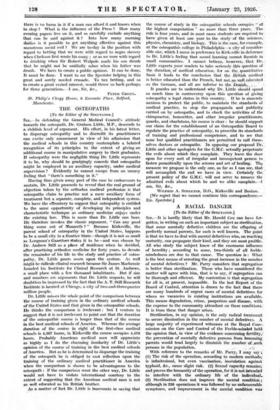THE OSTEOPATHS [To the Editor of the SPECTATOR.] defending the
General Medical Council's attitude towards the osteopath, Dr. Graham Little, M.P., descends to a childish level of argument. His effort, in his latest letter, to disparage osteopathy and to discredit its practitioners can excite only amusement in view of his admission that the medical schools in this country contemplate a belated recognition of its principles to the extent of giving an additional course in manipulative surgery to their graduates. If osteopathy were the negligible thing Dr. Little represents it to be, why should he grudgingly concede that osteopaths might be employed in an auxiliary capacity, under medical supervision ? Evidently he cannot escape from an uneasy feeling that "there's something in it."
Having thus given away part of the case he endeavours to sustain, Dr. Little proceeds to reveal that the real ground of objection taken by the orthodox medical profession is that osteopaths claim to practise not a mere auxiliary form of
treatment but a separate, complete, and independent system. We have the effrontery to suggest that osteopathy is entitled to the same opportunity of developing its principles and characteristic technique as ordinary medicine enjoys under the existing law. This is more than Dr. Little can bear. He therefore invokes the classic argument, " Can any good thing come out of Nazareth " Because Kirksville, the parent school of osteopathy in the United States, happens to be a small city in a frontier State—though it is not so small as Longman's Gazetteer states it to be—and was chosen by Dr. Andrew Still as a piece of residence when he decided, after practising orthodox medicine for forty years, to devote the remainder of his life to the study and practice of osteo pathy, Dr. Little pours scorn upon the system. As well might he ridicule clinical research because Sir James Mackenzie founded his Institute for Clinical Research at St. Andrews, a small place with a few thousand inhabitants. But if size and numbers are arguments that Dr. Little respects, he will doubtless be impressed by the fact that the A. T. Still Research Inititute is located at Chicago, a city of two-and-threequarter million people.
Dr. Little misses the whole point of the comparison between
the course of training given in the ordinary medical schools of the United States and that given in the osteopathic schools. He thinks the comparison is irrelevant : but I venture to suggest that it is not irrelevant to point out that the duration of the osteopathic course is longer than that of the course in the best medical schools of America. Whereas the average duration of the course in eight of the first-class medical schools is 4,367 hours, in Kirksville the course occupies 4,410 hours. Probably American medical men will appreciate as highly as I do the charming insularity of Dr. Little's opinion of the course of training in the best medical schools of America. But as he is determined to disparage the training of the osteopath he is obliged to cast reflection upon the training of the ordinary medical practitioner in America when the comparison is shown to be advantageous to the osteopath : if the comparison went the other way, Dr. Little would not have to violate international courtesy to the extent of suggesting that the American medical man is not so well educated as his British brother.
As a matter of fact Dr. Little is inaccurate in saying that
the course of study in the osteopathic schools occupies " at the highest computation " no more than three years. The rule is four years, and in most cases students are required to have given at least one year to the study of the sciences,' physics, chemistry, and biology. This is the case, for example, at the osteopathic college in Philadelphia—a city of consider- able size, which I name in preference to Kirksville in deference to Dr. Little's feeling that sound learning cannot flourish in small communities. I cannot lbelicao, however, that Dr. - Little expects your readers to take seriously. this question of the duration, of medical education, for on the _quantitative basis it leads to the conclusion that the medical is better educated than the French, but uot,iso agall,cducated as the German, and all are inferior tothe -Daojal,i,„ , - It puzzles me to understand why Dr. ,Little should spend so much time in controversy upon this question of giving osteopathy a legal status in this country. If he is sincerely anxious to protect the public, to maintain the standards of medical practice, to stop the propaganda and publicity, carried on by osteopaths, and to check the activities of the chiropractor, bonesetter, and other irregular practitioners; quacks, and charlatans, his course is clear : he should support our claim for the establishment of an Osteopathic Board to regulate the practice of osteopathy, to prescribe its standards of training and professional competence, and to see that none but qualified practitioners are permitted to call them- selves doctors or osteopaths. In opposing our proposal Dr.',_ Little and other apologists for the G.M.C. actually perpetuate the evils about which they complain. They leave the door open for every sort of irregular and incompetent person to , fasten parasitically upon the science and art of healing. The measure we propose is the only one, as far as I can see, that will accomplish the end we have in view. Certainly the present policy of the G.M.C. will not serve to remove the admitted evils about which he and we alike complain.-1 am, Sir, &c., WiLsaro A. STREETER, D.O., Kirksville and Boston. [We regret that we cannot continue this correspondence.-- ED. Spectator.]










































 Previous page
Previous page